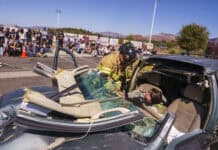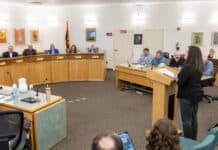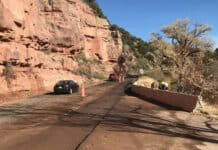Now that we have passed July 4 and are well into summer, we can expect monsoon and fire season to get into full swing.
Through the end of the summer, we can expect hot, cloudless days punctuated by days with heavy monsoon downpour from storms rolling up from Mexico and southern Arizona.
The monsoon is an annual shift in wind direction that brings heavy rain up from the Gulf of Mexico over the Mexican Plateau from the southeast or up the Sea of Cortez between the Baja peninsula and mainland Mexico. When the storms enter Arizona, they roll across the open Sonoran desert dropping precipitation north until they reach the cliffs of the Coconino Plateau that forms the northern boundary of the Verde Valley, meet cool air on top of it and pummel our valley with rain.
Above-normal large fire potential is expected across southern and central Arizona in July followed by normal potential for the remainder of the monsoon.
The current El Niño will remain weak or moderate category through at least the midsummer months and likely longer.
The early summer shows continued likelihood for moisture to be pulled westward across New Mexico towards and eventually west of the Continental Divide, which passes through the New Mexico side of the Arizona-New Mexico border. This means Sedona and Verde Valley residents need to remain hypervigilant against fire risk.
Over the last few weeks since school ended, many spots in Oak Creek Canyon have reached capacity as in-state tourists came up to our region to get out of sweltering heat in Phoenix and Tucson. This will continue through July and August. The onset of the monsoon could be delayed this summer across much of Arizona and generally focused more east of the divide overall.
Significant fire potential west of the divide could linger a bit longer than usual this July.
By later in July and August, monsoonal moisture in expected to be adequate or downright robust, some areas where significant large fire potential will be diminished.
There are also scores of tourists and some locals camping on U.S. Forest Service land around Sedona. The number of dispersed campers on the Coconino National Forest is compounded by the fact the Prescott National Forest closed the eastern slopes of Mingus Mountain to all camping, stretching from south of Camp Verde to west of Clarkdale.
All those who wanted to camp on Mingus now move east to open camping land nearer Sedona.
While we can do nothing to prevent lightning strike wildfires, it merely takes one reckless cigarette smoker, one unattended campsite or one campfire insufficiently extinguished after use to set off a wildfire that could consume dozens or hundreds of acres of wildland and perhaps threaten homes or properties in the Verde Valley.
We have already had numerous small fires start along roadways between Sedona, Cottonwood and Camp Verde due to vehicles and these were only put out by quick responses from the Sedona Fire District and neighboring fire agencies. Should the USFS impose fire bans on national forest land — which it does from time to time depending on risk — obey the rules.
If you see someone smoking in the forest, inform them of the fire risk and politely ask them to extinguish their cigarette and inform them about the risks our region faces this time of year. Most people are willing to crush out a cigarette if told the beautiful land they came visit could be ruined for years by one careless smoker.
You could point them to our website to see photos of fires that have hit the Sedona region in past years as well as the State Route 179 fires we had last month.
If you camp, make sure your campfire is completely extinguished well before your leave your site and methodically check it for embers before you depart. The fines for a wildfire can be enormous.
Please be safe while escaping the heat this summer. Remember that our public lands belong to us all and we are all responsible for keeping them safe.
Christopher Fox Graham
Managing Editor






















